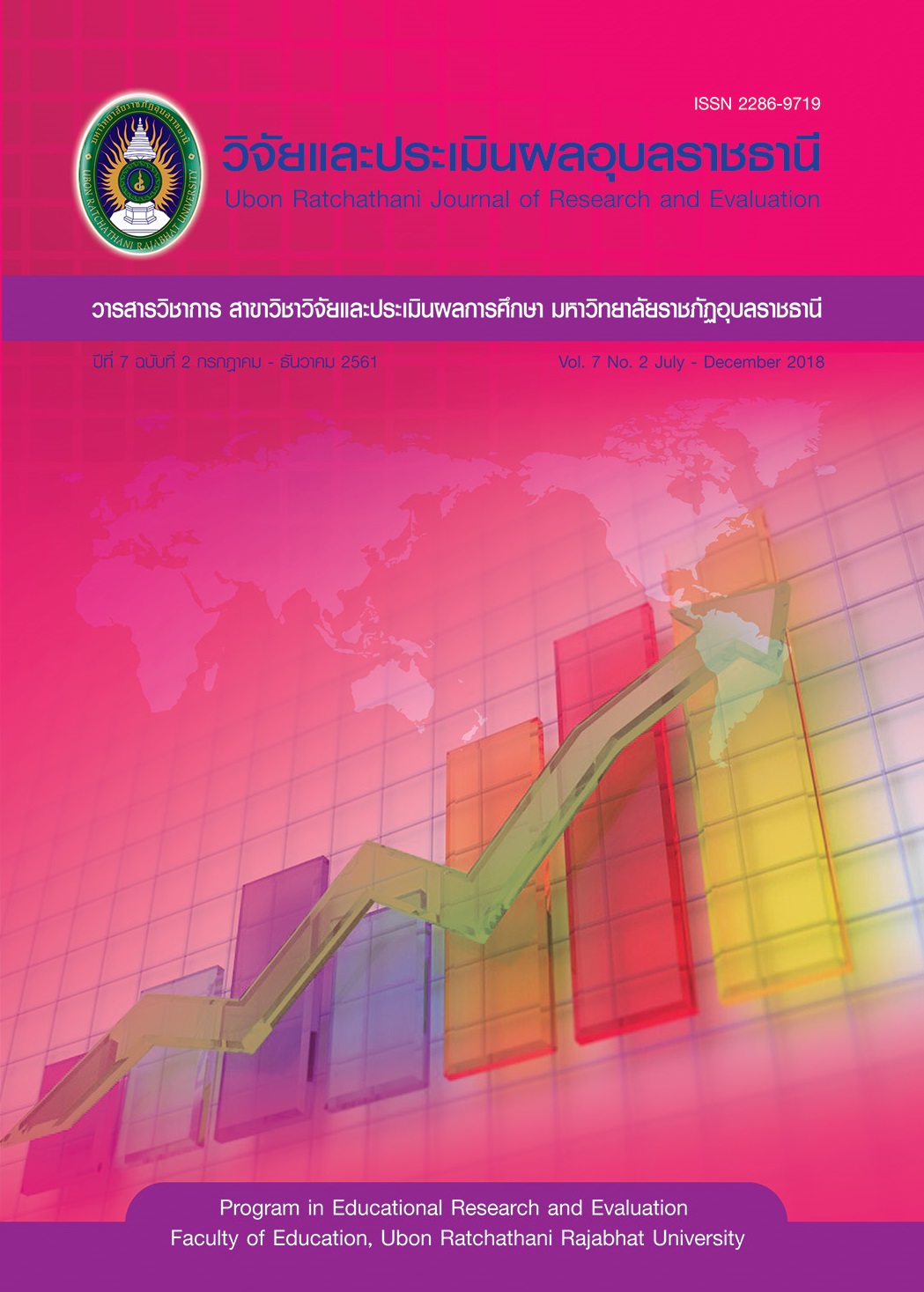การพัฒนาโปรแกรมทดสอบและประเมินวินิจฉัยทักษะการแก้โจทย์ปัญหา เรื่อง การประยุกต์สมการเชิงเส้นตัวแปรเดียว
คำสำคัญ:
การทดสอบแบบปรับเหมาะด้วยคอมพิวเตอร์, การประเมินวินิฉัย, ทักษะการแก้โจทย์ปัญหา, กระบวนการแก้โจทย์ปัญหาของโพลยาบทคัดย่อ
การวิจัยครั้งนี้มีวัตถุประสงค์เพื่อพัฒนาโปรแกรมทดสอบและประเมินวินิจฉัยทักษะการแก้โจทย์ปัญหา เรื่อง การประยุกต์สมการเชิงเส้นตัวแปรเดียว ดำเนินการวิจัยและพัฒนาเป็น 3 ขั้นตอน คือ การพัฒนาคลังข้อสอบ การสร้างและทดลองใช้โปรแกรม และการประเมินคุณภาพโปรแกรม ตามลำดับ
ผลการวิจัยพบว่า โปรแกรมประกอบด้วยคลังข้อสอบ เรื่อง การประยุกต์สมการเชิงเส้นตัวแปรเดียว จำนวน 48 ข้อ โปรแกรมสามารถประมาณค่าความสามารถของผู้สอบในรูปสัดส่วนของจำนวนครั้งของการตอบถูกตามทักษะการแก้โจทย์ปัญหา 4 ขั้น คือ ขั้นเข้าใจโจทย์ ขั้นวางแผนแก้ปัญหา ขั้นปฏิบัติตามแผน และ ขั้นตรวจสอบ โดยจำแนกระดับความสามารถของผู้สอบเป็นระดับย่อยได้ 5 ระดับ คือ ดีมาก ดี พอใช้ ต่ำ และต่ำมาก เมื่อนำไปให้ครูผู้สอนและนักเรียนใช้งาน และทำการประเมินคุณภาพของโปรแกรมหลังการใช้งาน พบว่า ครูผู้สอนเห็นว่าโปรแกรมมีประโยชน์ มีความเป็นไปได้ มีความเหมาะสม และมีความถูกต้องครอบคลุม ในระดับมากที่สุด ส่วนนักเรียนเห็นว่าโปรแกรมมีประโยชน์ มีความเป็นไปได้ มีความเหมาะสม และมีความถูกต้องครอบคลุมในระดับมาก
เอกสารอ้างอิง
Wm. C. Brown Publisher, 1978.
Frey, A., and N.N.Seitz. “Multidimensional Adaptive Testing in Educational and Psychological Measurement : Current State and Future Challenges,” Stud. Educ. Evalu.
35 (2009) : 89-97.
Half, R.. 6 Basic SDLC Methodologies: Which One is Best?. (online) 2016. (cited 10 April 2018). Available from: https://www.roberthalf.com/blog/salaries-and-skills/6-basic-sdlc-methodologies-which-one-is-best
Huebner, A. “An Overview of Recent Developments in Cognitive Diagnostic Computer Adaptive Assessments,” Practical Assessment, Research & Evaluation. 15, 3 (2010) : 1-7.
Ketterlin-Geller, L.R. and P. Yovanoff. “Diagnostic Assessments in Mathematics to Support Instructional Decision Making,” Practical Assessment, Research Evaluation.
14, 16 (2009) : 1-11.
Lester, F. K. Ideas about Problem-Solving: A look at Some Psychology Research. Arithmetic Teacher. 25, 2 (November 1977) : 12-14.
Lindquist, E.F. Educational Measurement. Washington : American Council of Education, 1951.
National Institute of Educational Testing Service (Public Organization). Annual Report 2016. (online) 2016 (cited 10 April 2018). Available from: https://www.niets.or.th/uploads/content_pdf/pdf_1503649895.pdf. [in Thai].
Parshall, C.G., T. Davey and P.J. Pashley. “Innovative Item Types for Computerized Testing,”
In W. J. van der Linden & C.A.W. Glas (Eds.). Computerized Adaptive Testing : Theory and Practice. Netherlands : Kluwer, 2002.
Perdikaris, S.C. “Applications of Ergodic Chains to Problem Solving,” International Journal of Mathematical Education in Science and Technology. 24:3, (1993) : 423-427.
Polya, G. "How to Solve It". 2nd ed. New Jersey : Princeton University Press, 1957.
Senarat S., S. Tayraukham, C. Piyapimonsit and S. Tongkhambanjong. “Development of a Computerized Adaptive Testing for Diagnosing the Cognitive Process of Grade 7 Students in Learning Algebra, Using Multidimensional Item Response Theory,” Educational Research and Reviews. Kenya. 8, 13, (2013) : 1009-1021.
The Institute for the Promotion of Teaching Science and Technology. The Basic Education Core Curriculum B.E. 2551 (A.D. 2008) Mathematics. (online) 2018 (cited 10 April 2018). Available from: https://www.ipst.ac.th/images/stories/files/Curriculum/MathCur_2008_ EngVersion.pdf.2008.
Thompson, Nhan A. and David A. Weiss. “A Framework for the Development of Computerized Adaptive Tests,” Practical Assessment, Research & Evaluation. 16, 1 (2011) : 1-9.
ดาวน์โหลด
เผยแพร่แล้ว
รูปแบบการอ้างอิง
ฉบับ
ประเภทบทความ
สัญญาอนุญาต
1. บทความที่ตีพิมพ์ในวารสารนี้ได้มีการตรวจสอบการลอกเลียนงานวรรณกรรมแล้ว ไม่เกินร้อยละ 25
2. บทความที่ตีพิมพ์ในวารสารนี้เป็นข้อคิดเห็น ข้อค้นพบของผู้เขียนบทความ โดยผู้เขียนบทความต้องเป็นผู้รับผิดชอบต่อผลทางกฎหมายใด ๆ ที่อาจเกิดขึ้นจากบทความนั้น ๆ
3. บทความ ข้อมูล เนื้อหา รูปภาพ ฯลฯ ที่ได้รับการตีพิมพ์ในวารสารวิจัยและประเมินผลอุบลราชธานี ถือเป็นลิขสิทธิ์ของวารสารวิจัยและประเมินผลอุบลราชธานี หากบุคคลหรือหน่วยงานใดต้องการนำทั้งหมดไปเผยแพร่ต่อหรือเพื่อกระทำการใดๆ จะต้องได้รับอนุญาตเป็นลายลักษณ์อักษรจากวารสารวิจัยและประเมินผลอุบลราชธานีก่อนเท่านั้น และจะต้องมีการอ้างอิงวารสารวิจัยและประเมินผลอุบลราชธานี ฉบับนั้น ๆ ด้วย






